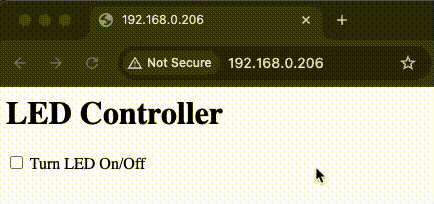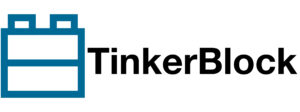We have learned how to display dynamic information using a Web Server. In this project, we will take it a step further by enabling interaction with the user to capture input from the website. The user can toggle a checkbox to turn the LED on or off. The ESP32 will then respond by sending the LED’s current state back to the webpage, where it will be displayed in real-time.
#include <WebServer.h>
const int ledPin = 23;
WebServer webServer(80);
void handleRoot() {
String htmlContent = R"rawliteral(
<html>
<body>
<h1>LED Controller</h1>
<input type="checkbox" id="ledCheckbox" onchange="sendCheckboxStatus()">
<label id="ledLabelText">Turn LED On/Off</label><br>
<script>
function sendCheckboxStatus() {
// Check if the checkbox is checked
var isChecked = document.getElementById("ledCheckbox").checked;
// Send the checkbox status (true or false) to the ESP32
fetch('/setLedStatus?status=' + isChecked)
.then(response => response.text())
.then(data => {
// Update the text next to the checkbox with the server response
document.getElementById("ledLabelText").innerText = data;
});
}
</script>
</body>
</html>
)rawliteral";
webServer.send(200, "text/html", String(htmlContent));
}
void handleSetLedStatus() {
// Get the value of the "status" parameter from the URL
String status = webServer.arg("status");
if (status == "true") {
digitalWrite(ledPin, HIGH); // Turn the LED on
webServer.send(200, "text/plain", "LED is On");
} else {
digitalWrite(ledPin, LOW); // Turn the LED off
webServer.send(200, "text/plain", "LED is Off");
}
}
void setup() {
Serial.begin(115200);
pinMode(ledPin,OUTPUT);
connectToWiFi();
webServer.on("/", HTTP_GET, handleRoot);
webServer.on("/setLedStatus", HTTP_GET, handleSetLedStatus);
webServer.begin();
}
void loop() {
webServer.handleClient();
}webServer.on("/", HTTP_GET, handleRoot);
webServer.on("/setLedStatus", HTTP_GET, handleSetLedStatus);We have two routes in this project. The root route serves the HTML page to the user. When the user toggles the checkbox, JavaScript sends the checkbox status to the /setLedStatus route, which is handled by the handleSetLedStatus function.
function sendCheckboxStatus() {
// Check if the checkbox is checked
var isChecked = document.getElementById("ledCheckbox").checked;
// Send the checkbox status (true or false) to the ESP32
fetch('/setLedStatus?status=' + isChecked)
.then(response => response.text())
.then(data => {
// Update the text next to the checkbox with the server response
document.getElementById("ledLabelText").innerText = data;
});
}This function sends the status of a checkbox (checked or unchecked) to the ESP32 using a fetch request. It then updates the text next to the checkbox with the response received from the ESP32.
String status = webServer.arg("status");This line retrieves the value of the “status” parameter from the HTTP request sent to the server and stores the extracted value as a String. It captures the “status” sent from the web page, such as “true” or “false”.
if (status == "true") {
digitalWrite(ledPin, HIGH); // Turn the LED on
webServer.send(200, "text/plain", "LED is On");
} else {
digitalWrite(ledPin, LOW); // Turn the LED off
webServer.send(200, "text/plain", "LED is Off");
}This code checks the value of status. If status is “true”, it turns the LED on and sends “LED is On” as a response. Otherwise, it turns the LED off and sends “LED is Off” as a response.


